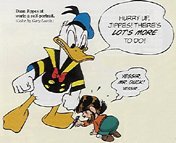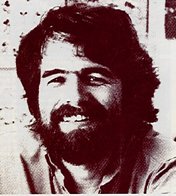


Jippes first encountered comics at the age of five in his native Amsterdam. Each day on the way to school he would pass a bookshop. It was 1950, two years before Holland started publishing its Donald Duck weekly, but the shop displayed a Belgian Mickey Mouse comic, and whenever young Daan passed the window, he looked to see if there was a new issue. He had no pocket money and would have stumbled over the French text, but he was fascinated by the cover art. As soon as he could read he begged a subscription, and then one to Donald Duck. "That's how it all started," he recalls. "I spent hours tracing poses from those stories. I knew that somehow I wanted to make this my work."
There followed the usual run of schools and a brief stint in the Dutch army, after which the boy found himself in need of a job. Since he had been sketching steadily for twenty years, it was not too hard to put together a portfolio and show it around the major Dutch art agencies. All adviced him to apply to a firm called Illustrated Press, which published a range of family magazines-including Donald Duck. Jippes' heart must have skipped a beat. Dreams really do come true, as Disney's publicists say.
His initial duties as layout artist on a women's journal were not so glamorous as his dreams. But with several publications all situated under one roof, Jippes could slide back and forth betweeen assignments. He began drawing weekly strips in various magazines, narrowed his work to cover art for Donald Duck, and gradually became a fixture on the staff. By 1975 his role had increased to that of art director. He would report twice a week to look over submissions from a cadre of cartoonists and writers, most of them freelancers like himself. Some stories could be pollished on the spot; the rest he took home. It was excellent training but must have been frustrating, for Jippes seldom had the chance to see a comic of his own evolve from plot to finished inks. "Most of my contributions were in the shape of pencil scripts. I didn't do much final art; I started up the motor and guided others. 'Hot Ducks' [published as "Banquet Behind Bars" in WDC&S #604] was one of the exceptions. I wanted to do some pages by myself from start to finish." The story ran three pages, but that was enough do draw praise from Barks and attract the attention of Danish cartoonist Freddy Milton. The result was an intense and fruitful collaboration betweeen the two Europeans. "Freddy's stories were quite ambitious. I wrote him letters analyzing the scripts, offering suggestions. That took hours. Some of the stories went through three drafts."
By 1979 the art director was looking for a change. He packed a fresh portfolio and flew to Burbank-Disney's heartland, as he calls it. There his drawings of Mickey impressed Eric Larson, one of Disney's legendary Nino Old Men, and Daan was invited to become part of the studio. For the next fifteen years he labored on a variety of projects from T-shirts to featured films. Having first proved his worth on the Mickey Mouse Sunday strip, he graduated to animation: storyboards and character styling for The Prince and the Pauper, The Rescuers Down Under, and Aladdin. 1992 was spent in Paris directing the European merchandising art for Beauty and the Beast. Today Daan is back in Burbank, hard to work on Disney's animated feature for 1998. All this time he has continued to freelance covers and stories for the Illustrated Press, many of which are reprinted in Gladstone's line of comics.
In a field where egos run high, Jippes is roundly regarded as the best of the Barks imitators. Colleagues like William Van Horn and Don Rosa praise his ability to ape the Barks duck of the forties, fifties, even the slicker-looking Donald of the 1960s- It would be hard to imagine anyone else completing the Junior Woodchuck tales that Barks dashed off twenty years ago in the form of sketch scripts. Jippes has drawn and inked eight of these, one of which appears following this article, and hopes someday to finish all 24 in a properly Barksian fashion. Betweentimes he lets traces of Walt Kelly and Paul Murry slip into his art. "Nobody holds a firm grip on me," he insists. "To get stuck in one style would be artistic death. I'm not concerned with developing a Jippes duck; whatever comes out will be Jippes. But I want to give the covers some variety."
In person Daan Jippes is big-boned and bearded. He fills a chair or an office rather quickly. But he talks softly, with the rueful chuckle of someone who has seen behind a few too many doors in the entertainment industry. His smouldering ambition remains what it was twenty years ago: to see one artistic project through from start to finish. As he continues to rise up the animation ladder, there's every chance he will do so.
And in the meantime there are all those Woodchuck scripts.
This profile was written by Geoffrey Blum, and run in WDC&S 607.